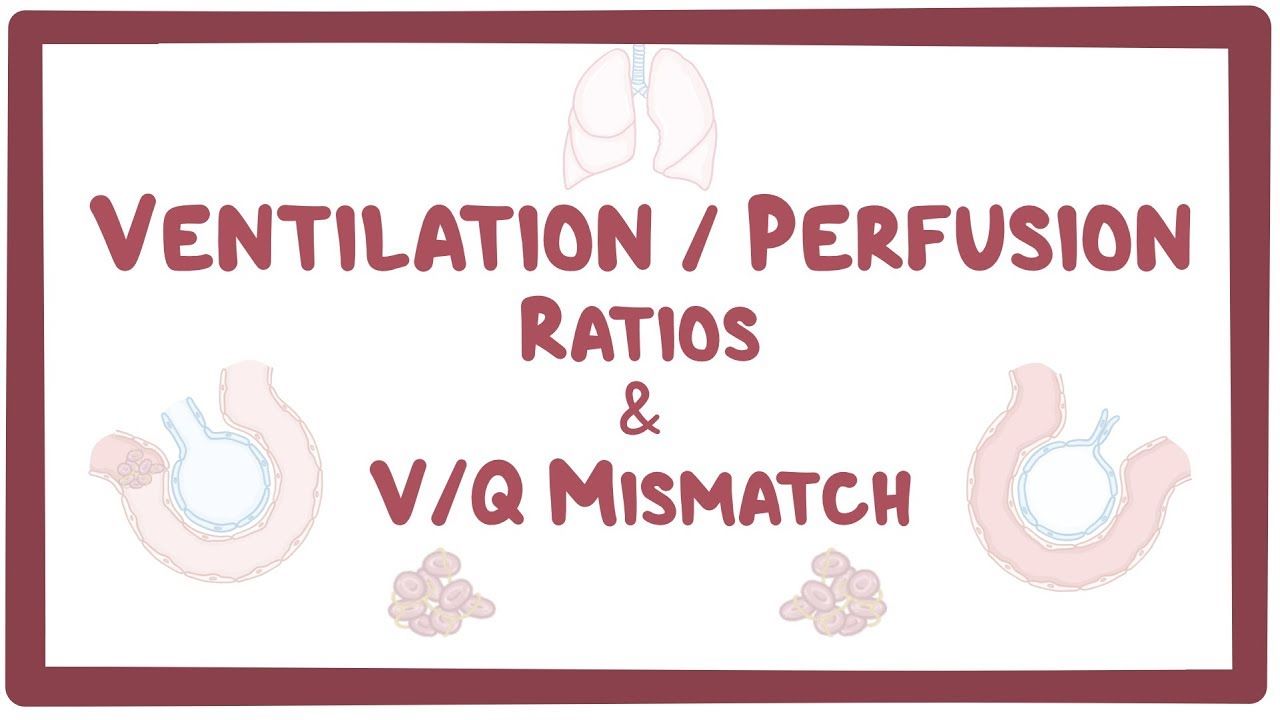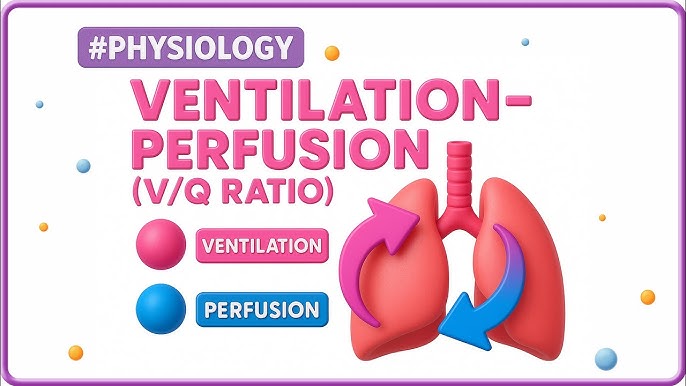Have you ever wondered why your lungs sometimes struggle to get enough oxygen, even when you’re breathing normally? The answer might lie in something called ventilation-perfusion mismatch.
Understanding this concept can help you grasp why certain breathing problems happen and how they affect your body. You’ll discover what ventilation-perfusion mismatch really means, why it matters to your health, and what signs you should watch out for. Keep reading—this knowledge could make a big difference in how you take care of your lungs and overall well-being.

Credit: quizlet.com
Ventilation Perfusion Basics
Understanding the basics of ventilation and perfusion is key to grasping what ventilation-perfusion mismatch means. These two processes work together to ensure your lungs efficiently exchange gases. When this balance is off, your body struggles to get the oxygen it needs or to expel carbon dioxide properly.
How Ventilation And Perfusion Work
Ventilation is the process of moving air in and out of your lungs. It brings fresh oxygen to the alveoli, tiny air sacs where gas exchange happens. Perfusion is the flow of blood through the pulmonary capillaries surrounding these alveoli.
Think of ventilation as the delivery of oxygen to the lungs, and perfusion as the blood picking up that oxygen to carry it throughout your body. Both need to happen at the right time and place for your body to function well.
Importance Of Matching Ventilation And Perfusion
When ventilation and perfusion match perfectly, oxygen enters your blood efficiently, and carbon dioxide leaves without issue. But what happens if one is high and the other is low? This imbalance is what doctors call ventilation-perfusion mismatch.
Imagine you have plenty of air reaching your lungs but not enough blood to pick up the oxygen. Or, blood flows through parts of the lung that aren’t getting enough air. This mismatch can cause breathlessness, fatigue, and other serious symptoms.
Have you ever wondered why some lung diseases make it so hard to breathe even when your lungs seem clear? It’s often because the ventilation and perfusion are out of sync, disrupting your body’s delicate gas exchange balance.

Credit: www.osmosis.org
Causes Of Ventilation Perfusion Mismatch
Ventilation perfusion mismatch happens when the air reaching your lungs doesn’t match the blood flow in your lung vessels. This imbalance can seriously affect how well your body gets oxygen and removes carbon dioxide. Understanding what causes this mismatch helps you recognize risks and manage symptoms more effectively.
Airway Obstruction
Airway obstruction blocks the flow of air into parts of your lungs, leading to poor ventilation. This can happen due to mucus buildup, foreign objects, or swelling from infections. Have you ever experienced shortness of breath during a cold? That’s a mild example of airway obstruction affecting ventilation.
Pulmonary Embolism
Pulmonary embolism occurs when a blood clot blocks the vessels in your lungs. This stops blood from reaching areas where air is available, causing a severe mismatch. If you notice sudden chest pain or difficulty breathing, it could be a sign of this dangerous condition needing immediate attention.
Chronic Lung Diseases
Diseases like chronic obstructive pulmonary disease (COPD) and asthma change how your lungs work over time. They can damage airways or reduce lung elasticity, making it harder for air and blood to match up properly. Managing these diseases well can reduce the mismatch and improve your breathing comfort.
Cardiac Conditions
Your heart plays a key role in pumping blood through the lungs. Conditions such as heart failure or valve problems can disrupt this flow, causing less blood to reach well-ventilated areas. Are you aware of how your heart health affects your lung function? Keeping your heart healthy supports better oxygen delivery.
Symptoms To Watch For
Recognizing the symptoms of ventilation perfusion mismatch early can make a significant difference in managing your health. This condition affects how well oxygen and blood flow match up in your lungs, which directly impacts your breathing and energy levels. Pay attention to these signs so you can seek help promptly and avoid complications.
Shortness Of Breath
One of the most noticeable symptoms is shortness of breath, especially during activities that didn’t used to tire you out. You might feel like you can’t get enough air, even when resting. This happens because your lungs aren’t efficiently exchanging oxygen and carbon dioxide, leaving your body gasping for breath.
Cough And Chest Pain
A persistent cough can be a warning signal. It may not always produce mucus but can feel irritating and stubborn. Chest pain, particularly sharp or stabbing discomfort, can also occur because of uneven blood flow in your lungs. If you notice these symptoms, especially together, it’s important to discuss them with your healthcare provider.
Fatigue And Cyanosis
Feeling unusually tired or weak without a clear reason is another symptom to watch. Your body struggles when oxygen levels are low, which can drain your energy quickly. Cyanosis, a bluish tint to your lips or fingertips, indicates that your blood isn’t carrying enough oxygen. Have you ever felt tired for no obvious reason and noticed a change in your skin color? This could be a subtle sign of a ventilation perfusion mismatch.

Credit: www.youtube.com
Diagnosis Techniques
Diagnosing ventilation perfusion mismatch involves several techniques that help doctors understand lung function. These tests check how well air and blood flow match in the lungs. Accurate diagnosis guides effective treatment and improves patient care.
Imaging Tests
Imaging tests provide visual details of lung structure and function. A common test is the ventilation-perfusion (V/Q) scan. It uses small amounts of radioactive material to show airflow and blood flow in the lungs. This test identifies areas where air and blood flow do not match.
Chest X-rays and CT scans help detect lung diseases causing mismatch. They reveal blockages, fluid buildup, or damage in lung tissues. These images assist in confirming the cause of ventilation perfusion mismatch.
Blood Gas Analysis
Blood gas analysis measures oxygen and carbon dioxide levels in the blood. A small blood sample, usually from an artery, is tested. This test shows how well the lungs transfer oxygen into the blood and remove carbon dioxide.
Abnormal results suggest problems with lung ventilation or blood flow. It helps doctors assess the severity of the mismatch and monitor treatment progress.
Pulmonary Function Tests
Pulmonary function tests (PFTs) measure lung capacity and airflow. They include spirometry, which records how much air a person can breathe out and how fast. These tests detect lung diseases affecting ventilation.
PFTs identify breathing problems contributing to ventilation perfusion mismatch. They also help track changes in lung function over time, guiding therapy decisions.
Treatment Approaches
Treatment for ventilation-perfusion mismatch focuses on improving air flow and blood flow in the lungs. Doctors may use oxygen therapy, medications, or devices to support breathing. Addressing the underlying cause is key to restoring proper lung function.
Ventilation Perfusion Mismatch can be a complex condition, but understanding the treatment approaches can make a significant difference. Each approach targets the underlying cause, aiming to enhance breathing and improve oxygen levels in your body. Let’s explore some of the main treatment strategies that can help manage this condition effectively.Medications
Medications play a crucial role in managing Ventilation Perfusion Mismatch. Bronchodilators, for instance, help open up the airways, making it easier for you to breathe. Anti-inflammatory drugs may also be prescribed to reduce swelling in your airways. Blood thinners can prevent clots that might worsen the mismatch. Each medication is tailored to your specific needs, so always consult your doctor before starting any new treatment.Oxygen Therapy
Oxygen therapy can be a game-changer if you’re struggling with low oxygen levels. By providing supplemental oxygen, this approach ensures that more oxygen reaches your bloodstream. Imagine how your energy levels might improve when your body gets the oxygen it needs. This therapy can be administered at home or in a healthcare setting, depending on the severity of your condition.Surgical Options
In some cases, surgery might be necessary to correct structural issues causing the mismatch. Procedures like pulmonary thromboendarterectomy can remove blockages in your pulmonary arteries. Think about how removing these blockages could improve blood flow and enhance your breathing. While surgery might seem daunting, it can be life-changing for those with severe conditions. Considering these treatment approaches, which one resonates with you the most? Each has its unique benefits and understanding them can empower you to make informed decisions about your health.Preventing Ventilation Perfusion Mismatch
Preventing ventilation perfusion mismatch is crucial for maintaining healthy lungs and efficient oxygen exchange. This condition happens when air and blood flow in the lungs do not match, leading to poor oxygen supply to the body. Simple actions can help keep this balance intact and support better breathing.
Lifestyle Changes
Healthy habits play a big role in preventing ventilation perfusion mismatch. Avoid smoking, which harms lung tissue and blood vessels. Stay active with regular exercise to improve lung function and circulation. Maintain a balanced diet to support overall health and keep your immune system strong. Drink plenty of water to keep mucus thin and lungs clear. Avoid exposure to pollutants and allergens that can cause lung irritation.
Managing Underlying Conditions
Many health problems can cause ventilation perfusion mismatch. Control asthma by following your doctor’s advice and taking prescribed medicine. Manage chronic obstructive pulmonary disease (COPD) to keep your lungs working well. Treat infections like pneumonia quickly to avoid lung damage. Regular check-ups help detect issues early. Proper management of heart conditions can also improve blood flow in the lungs.
Frequently Asked Questions
What Is Ventilation Perfusion Mismatch In Lungs?
Ventilation perfusion mismatch occurs when air flow and blood flow in the lungs do not align. This disrupts efficient oxygen exchange, leading to reduced oxygen levels in the blood and potential breathing difficulties.
What Causes Ventilation Perfusion Mismatch?
Common causes include pulmonary embolism, chronic obstructive pulmonary disease (COPD), pneumonia, and asthma. These conditions affect either airflow or blood flow, resulting in an imbalance and impaired gas exchange.
How Is Ventilation Perfusion Mismatch Diagnosed?
Doctors use imaging tests like V/Q scans, chest X-rays, and CT scans. Blood gas analysis also helps detect oxygen and carbon dioxide imbalances related to the mismatch.
What Are Symptoms Of Ventilation Perfusion Mismatch?
Symptoms include shortness of breath, rapid breathing, low oxygen levels, and fatigue. Severe mismatch can cause chest pain and confusion due to poor oxygen delivery.
Conclusion
Ventilation perfusion mismatch affects how well your lungs work. It happens when air and blood flow do not match in the lungs. This can cause breathing problems and low oxygen levels. Doctors use tests to find this mismatch and decide on treatment.
Understanding it helps in managing lung diseases better. Take care of your lungs by avoiding smoking and pollution. Healthy lungs mean better breathing and more energy every day. Keep learning about your health to stay strong and well.





